Halls Island
Introduction
Text-to-speech Audio
Like neighboring Virginius Island, Halls Island was one of Harpers Ferry’s industrial centers. Robert Harper constructed his sawmill here in the 1750s and after the U.S. government purchased the land in 1797 it was part of plans to expand travel on the Shenandoah River. The height of industry on Halls Island was during the 1820s-1840s when John Hall produced his patented Hall breechloading rifles at the Hall Rifle Works. After the destruction of the Civil War, Halls Island saw one more period of industry with the Shenandoah Pulp Mill from 1889 to 1935. Afterward, Halls Island largely returned to nature as the National Park Service began administering the property.
Images
Halls Island within Harpers Ferry National Historical Park
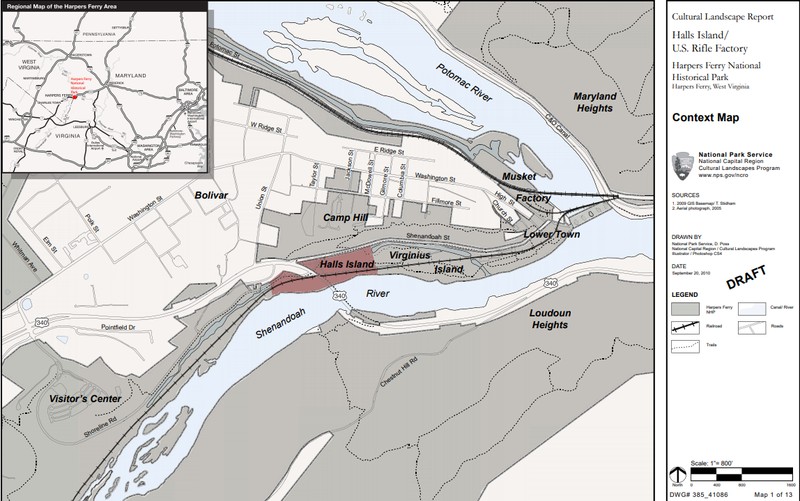
Plan for the 1803 Shenandoah Canal. Harper's sawmill and mill race locations are marked. (National Archives)
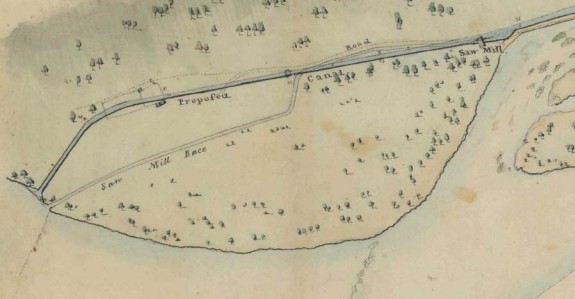
Halls Island to 1818
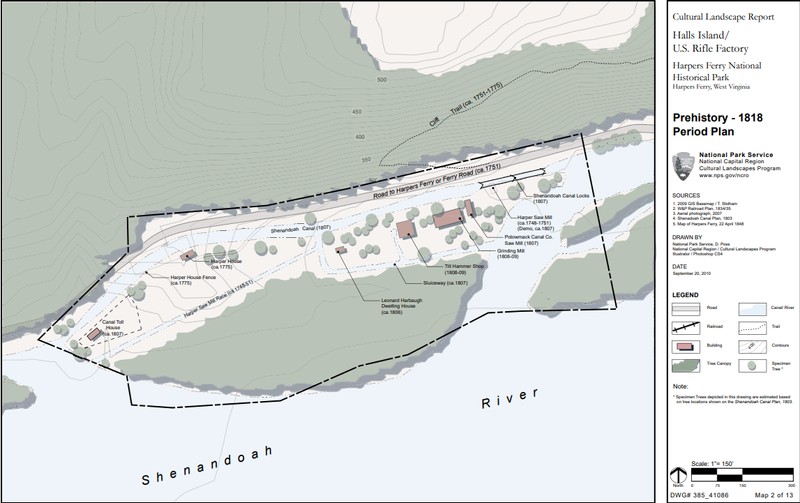
1834 map showing the location of the W & P Railroad and Halls Rifle Works
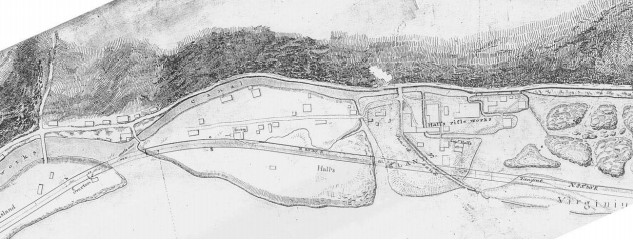
Halls Island 1819-1843
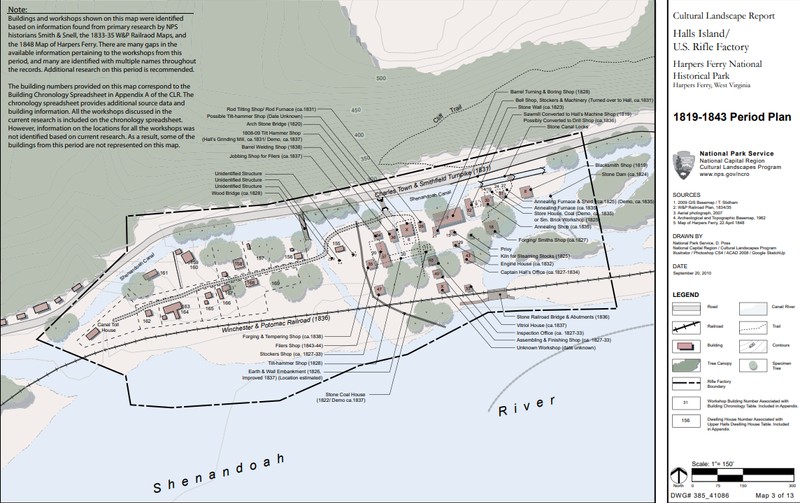
Model 1817 Hall U.S. Contract Breechloading Flintlock Rifle
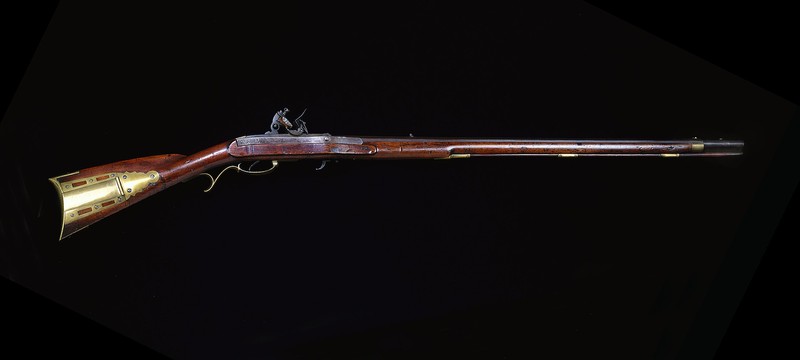
Map of Halls Island, April 22, 1848

1859 map of Hall's Rifle Factory buildings on Lower Hall Island
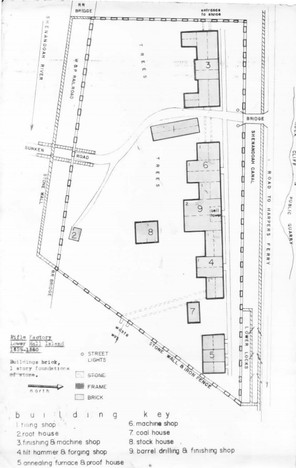
SKETCH OF RIFLE WORKS AT HARPERS FERRY, VIRGINIA, BY LIEUTENANT JAMES G. BENTON, CA. JUNE 1853. FROM THE UNITED STATES MILITARY ACADEMY, LIBRARY MANUSCRIPT COLLECTION, WEST POINT, NY. (IMAGE COURTESY OF THE HARPERS FERRY NHP ARCHIVES PHOTO COLLECTION).
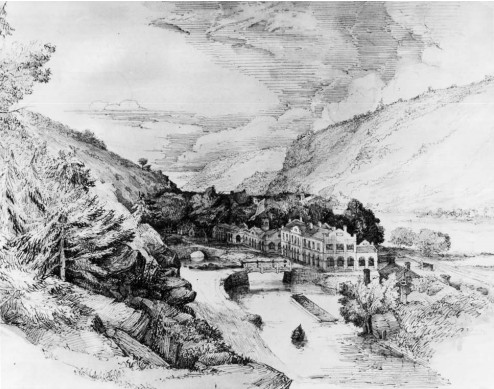
DETAIL VIEW OF HALLS ISLAND FROM THE SACHSE LITHOGRAPH CA.1854-1859. (IMAGE COURTESY OF HARPERS FERRY NHP HISTORIC PHOTO COLLECTION)
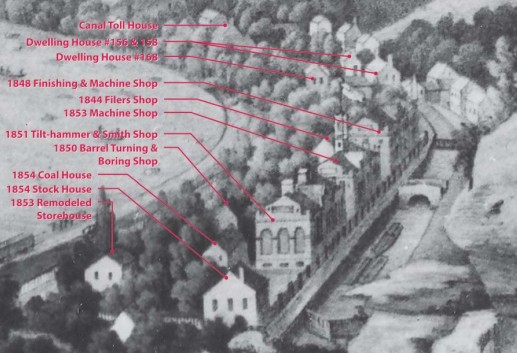
VIEW OF THE ISLAND VIRGINIUS, IN THE SHENANDOAH, AT HARPERS FERRY, TAKEN NEAR JEFFERSON’S ROCK. TAKEN FROM NATURE BY THOMAS SACHSE, LITHOGRAPHY BY E. SACHSE & CO., SUN IRON BLDG., BALTIMORE, MD. CA. 1854-1859. (IMAGE COURTESY OF HARPERS FERRY NHP HISTORIC PHOTO COLLECTION)
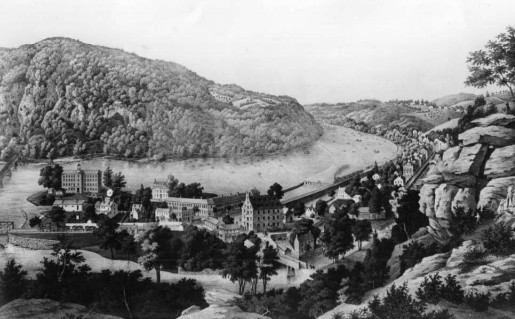
Halls Island 1861-1869
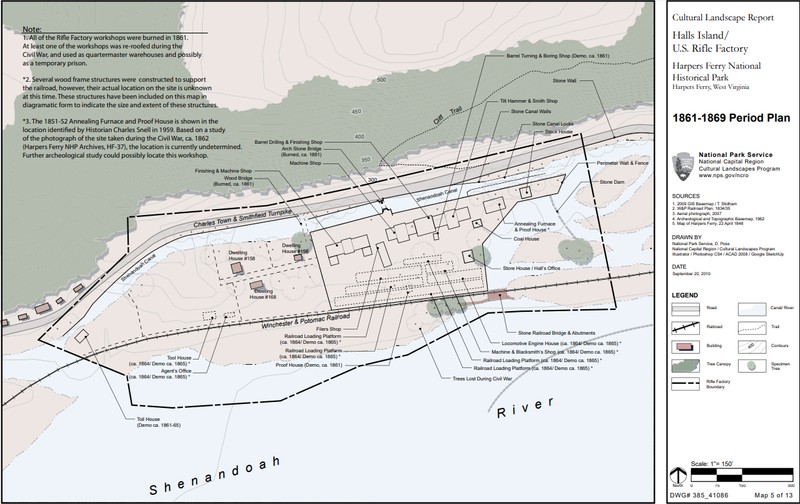
"Ruins of Hall's Rifle Works; Harper's Ferry, W.Va."
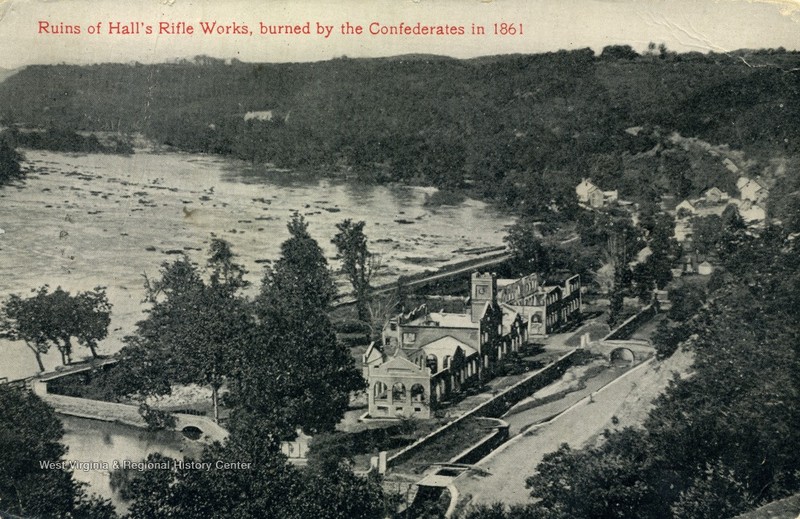
JOHN H. HALL’S RIFLE WORKS, U.S. RIFLE FACTORY ON THE SHENANDOAH RIVER, NEAR HARPERS FERRY, DESTROYED BY THE VIRGINIANS IN JUNE 1861, DRAWN BY A. THOMPSON FOR THE NEW YORK ILLUSTRATED NEWS, 1862. (IMAGE COURTESY OF HARPERS FERRY NHP HISTORIC PHOTO COLLECTION)
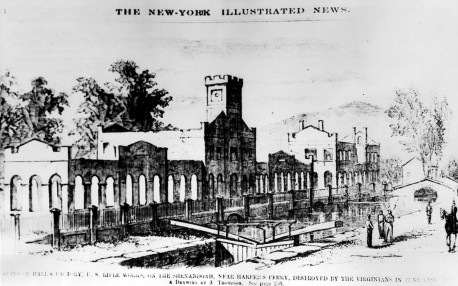
SAVERY’S HARPERS FERRY PAPER MILL ON THE POTOMAC RIVER CA. 1890S (IMAGE COURTESY OF HARPERS FERRY NHP HISTORIC PHOTO COLLECTION)
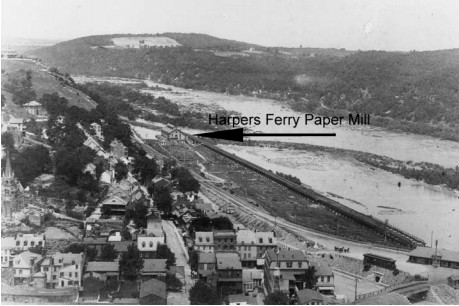
1894 map of the Shenandoah Pulp Mill
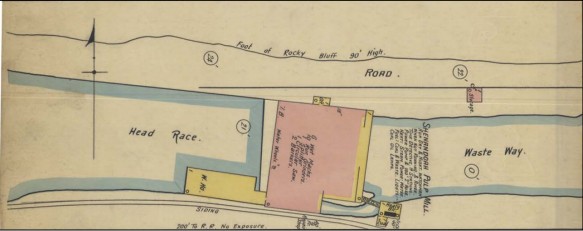
The Shenandoah Pulp Company and Lake Quigley are seen in the right back of this c. 1885-1936 photo.
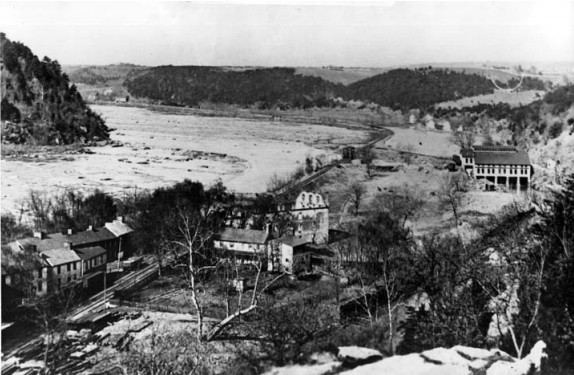
1889 view of the Shenandoah Pulp Company and Lake Quigley from upstream. The W & P Railroad separated Lake Quigley and the Shenandoah River.

Shenandoah Pulp Mill, 1938
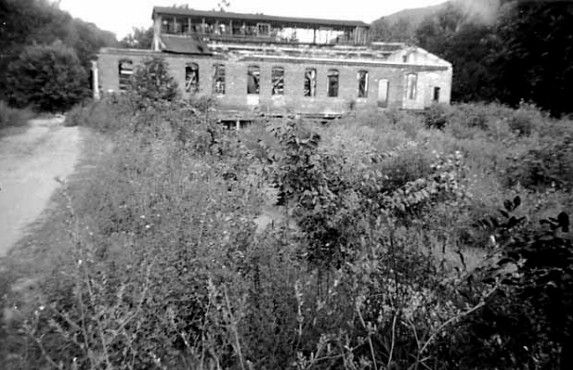
Halls Island, 1870-1944
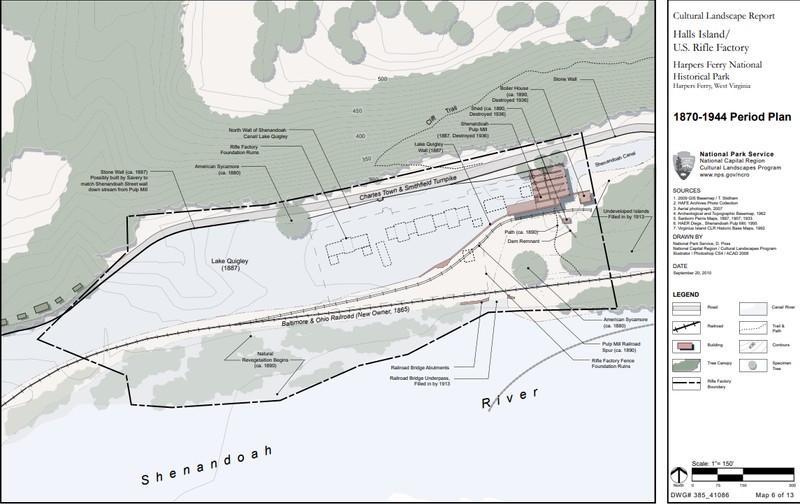
Halls Island, 1944-2010
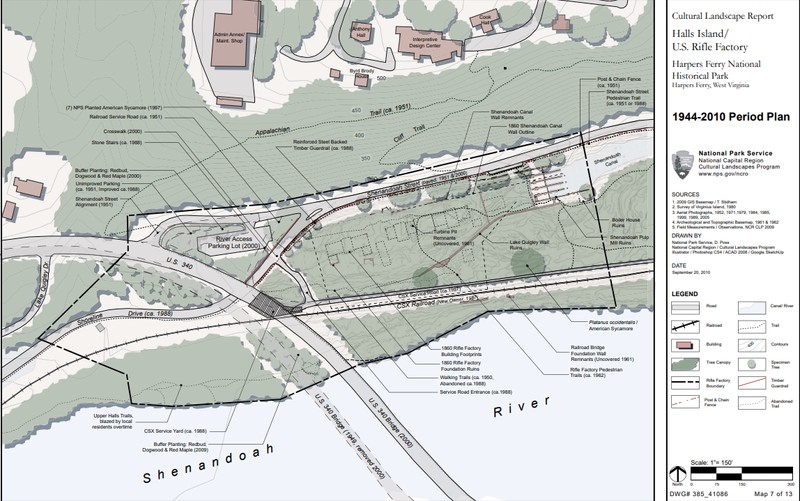
VIEW WEST, EAST ELEVATION FOUNDATION REMAINS. - Shenandoah Pulp Mill, Shenandoah Street, Harpers Ferry, Jefferson County, WV.
.jpg)
VIEW SOUTHWEST, NORTH AND EAST ELEVATIONS OF WALLS 1, 2, 3, 4, 5, 6. - Shenandoah Pulp Mill, Shenandoah Street, Harpers Ferry, Jefferson County, WV.
.jpg)
VIEW SOUTH, NORTH, EAST ELEVATIONS OF WALLS 3, 4, 5, 6, NOTE OPENINGS IN WALL 6. - Shenandoah Pulp Mill, Shenandoah Street, Harpers Ferry, Jefferson County, WV.
.jpg)
VIEW NORTHWEST, SOUTH AND EAST ELEVATIONS OF WALL 6 WITH OPENINGS, WALLS 5, 4, 3, 2, 1 IN BACKGROUND. - Shenandoah Pulp Mill, Shenandoah Street, Harpers Ferry, Jefferson County, WV.
.jpg)
VIEW WEST, FLUME BETWEEN WALLS 5 AND 6. - Shenandoah Pulp Mill, Shenandoah Street, Harpers Ferry, Jefferson County, WV.
.jpg)
VIEW NORTHEAST, WALLS 3 AND 4 (WALL 5 IN BACKGROUND RIGHT). - Shenandoah Pulp Mill, Shenandoah Street, Harpers Ferry, Jefferson County, WV.
.jpg)
VIEW NORTHEAST, WALLS 4 AND 5 WITH COLLAPSED FLOOR BETWEEN (WALL 3 IN BACKGROUND LEFT). - Shenandoah Pulp Mill, Shenandoah Street, Harpers Ferry, Jefferson County, WV.
.jpg)
VIEW SOUTHEAST, NORTH ELEVATION OF WALL 2, REMAINS OF TURBINE RACE WITH METAL RETAINING PLATE. - Shenandoah Pulp Mill, Shenandoah Street, Harpers Ferry, Jefferson County, WV.
.jpg)
VIEW NORTHEAST, SOUTH ELEVATION OF WALL 3, REMAINS OF TURBINE RACE WITH RETAINING PLATE DETAIL. - Shenandoah Pulp Mill, Shenandoah Street, Harpers Ferry, Jefferson County, WV.
.jpg)
VIEW SOUTHWEST, NORTH ELEVATION OF WALL 7, NOTE GATE POCKET IN MIDDLE DISTANCE. - Shenandoah Pulp Mill, Shenandoah Street, Harpers Ferry, Jefferson County, WV.
.jpg)
VIEW NORTHEAST, NORTH ELEVATION OF WALL 7, CONCRETE SECTION OF STONE RUBBLE WALL EAST OF MILL FOUNDATION. - Shenandoah Pulp Mill, Shenandoah Street, Harpers Ferry, Jefferson County, WV.
.jpg)
VIEW EAST, BOILERHOUSE FOUNDATION LOCATED TO THE SOUTHWEST OF THE MILL FOUNDATION. - Shenandoah Pulp Mill, Shenandoah Street, Harpers Ferry, Jefferson County, WV.
.jpg)
Backstory and Context
Text-to-speech Audio
When Robert Harper received a patent for the Harpers Ferry land in 1751 he constructed a grist mill and saw mill on Hall’s Island. The mills were located just above the “staircase” rapids on a site that Harper chose for the availability of waterpower from the Shenandoah. This was the beginning of industrial development at Harpers Ferry. Harper’s mills were early merchant mills where Harper brought in grain from area farmers and sent the processed flour to urban markets on the east coast, such as Baltimore.
Robert Harper died in September 1782 and he divided his land between a niece, Sarah Harper Wager, and a nephew, Robert Griffith. Sarah Harper Wager and her husband, John Wager, Sr., received the eastern half of the property (near the confluence of the rivers) and Robert Griffith received Hall’s Island, the two mills, and Harper’s residence. Griffith sold his portion of the land to speculators Thomas Rutherford, William Dark Van Rutherford, and Mary Rutherford on January 9, 1797. The Rutherfords quickly sold 310 acres of land to the United States government on February 20, 1797 for $10,000.
Hall’s Island was part of George Washington and the Potowmack Company’s plans for improving transportation from the Shenandoah Valley to the east coast. Starting in 1785 the Company wanted to improve the river channels and create a canal system along the Potomac River and the federal government gave the Potowmack Company a right of way on Hall’s Island in 1806. The Shenandoah Canal with locks at both ends of the island was constructed in 1807, destroying Harper’s original sawmill (they build a new sawmill in a different location). The second portion of the canal, which would have extended to connect to the Armory Canal on the Potomac, was planned but never constructed. Nevertheless, the Shenandoah canal provided a way around the “staircase” rapids on the Shenandoah River. The Potowmack Company succeeded in completing four other canals further upstream, opening the Shenandoah to transportation down to Harpers Ferry.
George Washington was also instrumental in bringing the federal armory to Harpers Ferry. In the early national period, with the new United States needing to build their own infrastructure and reduce dependence on foreign manufacturing, Washington pushed through legislation to establish up to four arsenals and during his term Springfield, MA and Harpers Ferry, VA were chosen as locations. The main Musket Factory was constructed along the Potomac River closer to the confluence of the rivers, but in 1808 the government decided to further expand the armory and construct two shops on Lower Halls Island, the Grinding Mill and Tilt Hammer Shop. At some point between 1807 and 1834 eleven houses were also constructed on Upper Halls Island and a canal toll house in 1807.
The largest period of industrial production on Halls Island occurred with the Hall Rifle Works between the 1820s and 1840s. John H. Hall of Portland, ME worked in woodworking as a young man and then moved to making firearms. In 1811 Hall designed a breechloading rifle which he patented that same year. The government was interested in Hall’s design after testing it in 1813, but Hall did not have the capability to mass produce the guns at the time. After a few more years improving his design and vying for government support, Hall was able to go to Harpers Ferry in 1818 to work with the armorers to construct several sample weapons. Another round of testing in Washington, D.C. yielded a government contract for 1,000 rifles in 1819. In order to produce the rifles, the Hall Rifle Works was constructed at Harpers Ferry. The rifle works included two workshops, the sawmill that was converted into a machine shop, and a Blacksmith shop. There were also likely some residences for workers constructed on Upper Halls Island. Between 1822 and the end of 1824 Hall produced the first batch of rifles and perfected his system of creating interchangeable parts.
With the success of the first set of interchangeable rifle parts, the federal government invested more into expanding the rifle works and ordered 1000 more Hall rifles. Improvements included workshops, furnaces, a kiln, more residences, and several other structures. After a Congressional review of Hall’s works, the government put in a third contract for his rifles. This initiated a third expansion of the rifle works between 1827 and 1829 that included a Smith Shop, a store house, changes to the grinding mill, and new residences. During the 1830s there were transportation improvements on Halls Island with work on a new canal and dam on the Shenandoah, the B & O Railroad, the C & O Canal, and nearby turnpikes. There was another round of repairs and expansions at Halls Rifle Works in 1836-1837, but then John H. Hall became ill and had to decrease his involvement in the rifle works. After Hall died in 1841 the government decided to stop production of the Hall Rifle and the final orders were completed in 1844.
Initially the island was considered one, known as Halls Island. With the creation of the canal and sluiceway channels for the rifle works, the island was split into two (Upper Halls and Lower Halls Islands) by 1833. In the period between 1844 and 1860 both islands were used for various purposes, but the industry of the rifle works ended and many of the buildings were demolished in the 1850s. The remaining workshops and storehouses on Halls Island were burned in summer 1861 near the beginning of the Civil War. While Harpers Ferry was constantly in between the Confederate and Union armies during the Civil War, Halls Island was not heavily used 1861-1864. In 1864 when Union General Phillip H. Sheridan was conducting the Shenandoah Campaign from Harpers Ferry, buildings on Halls Islands were repaired to support the military supply operations. The W & P Railroad, which had been destroyed earlier by Confederate forces was rebuilt in 1864 with several new buildings constructed on both Upper and Lower Halls Islands to support the rail line. By the end of the Civil War Harpers Ferry was largely destroyed and the new railroad structures that remained on Halls Islands were demolished by the government in 1866. With so much destruction of the federal armory, the government decided to sell off their land through public auction in 1869.
The absence of the federal government coupled with flooding in the 1870s reduced the amount of industry at Harpers Ferry, but in October 1884 new industry arrived at Harpers Ferry. Thomas Savery who worked for Pusey, Jones & Company, who manufactured papermaking machinery, began to develop his own machinery and process for producing wood pulp and paper, obtaining 32 patents for his work. Savery and investors purchased property to construct the Harpers Ferry Paper Mill. They purchased land from the Musket Factory on the Potomac River, including the John Brown fort, and purchased around 13 acres on the Rifle Factory property on Halls Island. At both sites Savery constructed ground wood pulp mills under the new Shenandoah Pulp Company and operations began in 1889. As demand for Savery’s pulp manufacturing decreased in the 1890s, he formed the Harpers Ferry Electric Lights & Power Co. and gradually converted some of the machinery to energy production.
After the flour mill on Virginius Island stopped production in the late 1880s, the Shenandoah Pulp Company purchased the island and used it primarily for residences. While the pulp mill on Halls Island continued to run, much of Virginius Island became a tourist and natural spot. In the 1920s, Savery saw back-to-back disasters with a fire at the Harpers Ferry Paper Mill and a destructive flood at the Shenandoah Pulp Company. In 1928 operations for the Pulp Company ceased and the National Electric Power Company purchased the entire operation (the Shenandoah Pulp Company, the Harpers Ferry Paper Company, and the Harpers Ferry Electric Light & Power Company). After winding down production, the company ceased operations in 1935. By the 1940s many of the buildings were already in demolition and more flooding further altered the landscape. In 1944, the National Park Service began administering the area, first as the Harpers Ferry National Monument and then Harpers Ferry National Historical Park.
Descriptions of some of the historic buildings, from the National Register of Historic Places Nomination:
Upper Hall Island:
Armory Dwelling No. 6—“erected between 1807 and 1834, was a two-story brick building with approximate dimensions of 22’ by 16’. It was probably rented by Francis Knap, an Armory Machinist.”
Armory Dwelling No. 7—“erected between 1807 and 1834, was a two-story stone building with approximate dimensions of 28’ by 28’. It was probably rented by John Mason, an Armory machine oiler.”
Armory Dwelling No. 8—“erected between 1807 and 1834, was a two-story brick building measuring approximately 36’ by 18’. It was probably occupied by John P. Fouke, an Armory employee, in 1859.”
Shenandoah Canal—traces of the canal are still visible. There was a wooden one-story toll house on the western end of the island that is now gone.
Lower Hall Island
Building No. 3—Finishing and Machine Shop: “had two brick stories atop stone foundations and measured 35-1/2’ by 128’. On each end of the rear of this main structure was a one-story wing measuring 24’ by 24’. The door and window frames were cast iron; the water table, cornice, and sills were of cut stone. The gutters and spouting were copper and the roof was sheet iron. Designed by Major John Symington, the building was erected in 1847-48 for about $29, 740.”
Building No. 1—Filing Shop: “had two brick stories on a stone foundation measuring 74’ by 25-1/2’. The roof covering was slate. The shop was designed by Maj. Symington and erected in 1844-45 at a cost of some $5,000.”
Building No. 6—Machine Shop: “had a stone basement and first story, a brick second story, and a sheet iron roof. On the center rear of the 87-3/4’ by 35’ shop was a 14’ by 36’ projection designed for use as an office. Designed by Maj. Symington, the building was erected in 1852-53 at a cost of $19,030.”
Building No. 9—Barrel Drilling and Finishing Shop: “had a stone foundation and first story and two brick stories with a sheet iron roof topped by a 70’ high bell tower. Measuring 57-1/2’ by 49-1/2”, this shop connected Buildings No. 6 and 4. Designed by Superintendent Alfred M. Barbour, it was erected in 1859-60 at a cost of $15,820.”
Building No. 4—Tilt Hammer and Forging Shop: “had a stone basement and first story, a brick second story, cur stone water table, steps, sills, and coping, cast iron door and window frames, and a slate roof. On the center rear of the 110’ by 25-1/2’ shop was a 14-1/2’ by 35’ projection serving as an office. Designed by Maj. Symington, the shop was built in 1849-50 for $22,130.”
Building No. 5—Annealing Furnace and Proof House: “a one-story brick building over a one-story stone foundation measuring 60’ by 36’. Two brick partition walls divided it into three separate compartments. It was designed by Maj. Symington and erected in 1851-52 at a cost of $5,000.”
Building No. 7—Coal House: “a one-story building of brick, 25’ by 21’ and 15’ high, with a sheet iron roof, used for the storage of coal and charcoal. Designed by Colonel Benjamin Huger, it was erected in 1853-54 for $650.”
Building No. 8—Stock House: “probably had two stories with a slate roof. Exact dimensions are unknown. Erected prior to 1835, it was converted in 1853-54 for the storage of rifle barrels. It was erected by Maj. Symington in 1844-45.”
Building No. 2—Proof House: “one-story frame building, 19-1/2’ by 15’, with a back wall of stone masonry 2-1/2’ thick, used for the proving of rifle barrels. It was erected by Maj. Symington in 1844-45.”
Sources
"Cultural Landscape Report: Halls Island: United States Rifle Factory and the Shenandoah Riverfront." Harpers Ferry National Historical Park. National Park Service. Accessed August 3, 2021. http://npshistory.com/publications/hafe/halls_island_clr.pdf.
"National Register of Historic Places Inventory--Nomination Form: Harpers Ferry National Historical Park." Accessed August 3, 2021. http://www.wvculture.org/shpo/nr/pdf/jefferson/66000041.pdf.
"Cultural Landscape Report: Halls Island: United States Rifle Factory and the Shenandoah Riverfront." Harpers Ferry National Historical Park. National Park Service. Accessed August 3, 2021. http://npshistory.com/publications/hafe/halls_island_clr.pdf.
"Cultural Landscape Report: Halls Island: United States Rifle Factory and the Shenandoah Riverfront." Harpers Ferry National Historical Park. National Park Service. Accessed August 3, 2021. http://npshistory.com/publications/hafe/halls_island_clr.pdf.
"Cultural Landscape Report: Halls Island: United States Rifle Factory and the Shenandoah Riverfront." Harpers Ferry National Historical Park. National Park Service. Accessed August 3, 2021. http://npshistory.com/publications/hafe/halls_island_clr.pdf.
"Cultural Landscape Report: Halls Island: United States Rifle Factory and the Shenandoah Riverfront." Harpers Ferry National Historical Park. National Park Service. Accessed August 3, 2021. http://npshistory.com/publications/hafe/halls_island_clr.pdf.
"Cultural Landscape Report: Halls Island: United States Rifle Factory and the Shenandoah Riverfront." Harpers Ferry National Historical Park. National Park Service. Accessed August 3, 2021. http://npshistory.com/publications/hafe/halls_island_clr.pdf.
"M1819 Hall rifle." Wikipedia. Accessed August 3, 2021.
"Cultural Landscape Report: Halls Island: United States Rifle Factory and the Shenandoah Riverfront." Harpers Ferry National Historical Park. National Park Service. Accessed August 3, 2021. http://npshistory.com/publications/hafe/halls_island_clr.pdf.
"Cultural Landscape Report: Halls Island: United States Rifle Factory and the Shenandoah Riverfront." Harpers Ferry National Historical Park. National Park Service. Accessed August 3, 2021. http://npshistory.com/publications/hafe/halls_island_clr.pdf.
"Cultural Landscape Report: Halls Island: United States Rifle Factory and the Shenandoah Riverfront." Harpers Ferry National Historical Park. National Park Service. Accessed August 3, 2021. http://npshistory.com/publications/hafe/halls_island_clr.pdf.
"Cultural Landscape Report: Halls Island: United States Rifle Factory and the Shenandoah Riverfront." Harpers Ferry National Historical Park. National Park Service. Accessed August 3, 2021. http://npshistory.com/publications/hafe/halls_island_clr.pdf.
"Cultural Landscape Report: Halls Island: United States Rifle Factory and the Shenandoah Riverfront." Harpers Ferry National Historical Park. National Park Service. Accessed August 3, 2021. http://npshistory.com/publications/hafe/halls_island_clr.pdf.
"Cultural Landscape Report: Halls Island: United States Rifle Factory and the Shenandoah Riverfront." Harpers Ferry National Historical Park. National Park Service. Accessed August 3, 2021. http://npshistory.com/publications/hafe/halls_island_clr.pdf.
"Ruins of Hall's Rifle Works; Harper's Ferry, W.Va." West Virginia History OnView. West Virginia & Regional History Center. Accessed August 3, 2021. https://wvhistoryonview.org/catalog/042606.
"Cultural Landscape Report: Halls Island: United States Rifle Factory and the Shenandoah Riverfront." Harpers Ferry National Historical Park. National Park Service. Accessed August 3, 2021. http://npshistory.com/publications/hafe/halls_island_clr.pdf.
"Cultural Landscape Report: Halls Island: United States Rifle Factory and the Shenandoah Riverfront." Harpers Ferry National Historical Park. National Park Service. Accessed August 3, 2021. http://npshistory.com/publications/hafe/halls_island_clr.pdf.
"Cultural Landscape Report: Halls Island: United States Rifle Factory and the Shenandoah Riverfront." Harpers Ferry National Historical Park. National Park Service. Accessed August 3, 2021. http://npshistory.com/publications/hafe/halls_island_clr.pdf.
"Cultural Landscape Report: Halls Island: United States Rifle Factory and the Shenandoah Riverfront." Harpers Ferry National Historical Park. National Park Service. Accessed August 3, 2021. http://npshistory.com/publications/hafe/halls_island_clr.pdf.
"Cultural Landscape Report: Halls Island: United States Rifle Factory and the Shenandoah Riverfront." Harpers Ferry National Historical Park. National Park Service. Accessed August 3, 2021. http://npshistory.com/publications/hafe/halls_island_clr.pdf.
"Cultural Landscape Report: Halls Island: United States Rifle Factory and the Shenandoah Riverfront." Harpers Ferry National Historical Park. National Park Service. Accessed August 3, 2021. http://npshistory.com/publications/hafe/halls_island_clr.pdf.
"Cultural Landscape Report: Halls Island: United States Rifle Factory and the Shenandoah Riverfront." Harpers Ferry National Historical Park. National Park Service. Accessed August 3, 2021. http://npshistory.com/publications/hafe/halls_island_clr.pdf.
"Cultural Landscape Report: Halls Island: United States Rifle Factory and the Shenandoah Riverfront." Harpers Ferry National Historical Park. National Park Service. Accessed August 3, 2021. http://npshistory.com/publications/hafe/halls_island_clr.pdf.
Historic American Engineering Record, Creator, and Thomas Savery. Shenandoah Pulp Mill, Shenandoah Street, Harpers Ferry, Jefferson County, WV. Jefferson County Harpers Ferry West Virginia, 1968. Documentation Compiled After. Photograph. https://www.loc.gov/item/wv0431/. Accessed August 3, 2021.
Historic American Engineering Record, Creator, and Thomas Savery. Shenandoah Pulp Mill, Shenandoah Street, Harpers Ferry, Jefferson County, WV. Jefferson County Harpers Ferry West Virginia, 1968. Documentation Compiled After. Photograph. https://www.loc.gov/item/wv0431/. Accessed August 3, 2021.
Historic American Engineering Record, Creator, and Thomas Savery. Shenandoah Pulp Mill, Shenandoah Street, Harpers Ferry, Jefferson County, WV. Jefferson County Harpers Ferry West Virginia, 1968. Documentation Compiled After. Photograph. https://www.loc.gov/item/wv0431/. Accessed August 3, 2021.
Historic American Engineering Record, Creator, and Thomas Savery. Shenandoah Pulp Mill, Shenandoah Street, Harpers Ferry, Jefferson County, WV. Jefferson County Harpers Ferry West Virginia, 1968. Documentation Compiled After. Photograph. https://www.loc.gov/item/wv0431/. Accessed August 3, 2021.
Historic American Engineering Record, Creator, and Thomas Savery. Shenandoah Pulp Mill, Shenandoah Street, Harpers Ferry, Jefferson County, WV. Jefferson County Harpers Ferry West Virginia, 1968. Documentation Compiled After. Photograph. https://www.loc.gov/item/wv0431/. Accessed August 3, 2021.
Historic American Engineering Record, Creator, and Thomas Savery. Shenandoah Pulp Mill, Shenandoah Street, Harpers Ferry, Jefferson County, WV. Jefferson County Harpers Ferry West Virginia, 1968. Documentation Compiled After. Photograph. https://www.loc.gov/item/wv0431/. Accessed August 3, 2021.
Historic American Engineering Record, Creator, and Thomas Savery. Shenandoah Pulp Mill, Shenandoah Street, Harpers Ferry, Jefferson County, WV. Jefferson County Harpers Ferry West Virginia, 1968. Documentation Compiled After. Photograph. https://www.loc.gov/item/wv0431/. Accessed August 3, 2021.
Historic American Engineering Record, Creator, and Thomas Savery. Shenandoah Pulp Mill, Shenandoah Street, Harpers Ferry, Jefferson County, WV. Jefferson County Harpers Ferry West Virginia, 1968. Documentation Compiled After. Photograph. https://www.loc.gov/item/wv0431/. Accessed August 3, 2021.
Historic American Engineering Record, Creator, and Thomas Savery. Shenandoah Pulp Mill, Shenandoah Street, Harpers Ferry, Jefferson County, WV. Jefferson County Harpers Ferry West Virginia, 1968. Documentation Compiled After. Photograph. https://www.loc.gov/item/wv0431/. Accessed August 3, 2021.
Historic American Engineering Record, Creator, and Thomas Savery. Shenandoah Pulp Mill, Shenandoah Street, Harpers Ferry, Jefferson County, WV. Jefferson County Harpers Ferry West Virginia, 1968. Documentation Compiled After. Photograph. https://www.loc.gov/item/wv0431/. Accessed August 3, 2021.
Historic American Engineering Record, Creator, and Thomas Savery. Shenandoah Pulp Mill, Shenandoah Street, Harpers Ferry, Jefferson County, WV. Jefferson County Harpers Ferry West Virginia, 1968. Documentation Compiled After. Photograph. https://www.loc.gov/item/wv0431/. Accessed August 3, 2021.
Historic American Engineering Record, Creator, and Thomas Savery. Shenandoah Pulp Mill, Shenandoah Street, Harpers Ferry, Jefferson County, WV. Jefferson County Harpers Ferry West Virginia, 1968. Documentation Compiled After. Photograph. https://www.loc.gov/item/wv0431/. Accessed August 3, 2021.
